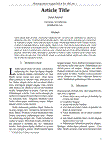| Sumario: | Traditionally, fish meal is the main dietary protein source in fish feed formulation,especially for carnivorous fish species such as salmon and eel. In general, fish feed contains5 to 50% of fish meal and shrimp feed contains marine animal protein at a level between30-50%. The rapid development of aquaculture will result in a high demand and a shortageof supply for fish meal. Besides of the limited availability, fishmeal is also a relativelyexpensive ingredient in aquafeed. Furthermore, the quality of fishmeal can vary to a largeextent, concerning to nutritional composition, pathogen and contamination of biogenicamines. Many researches, therefore, have been conducted to search alternative proteinsources as replacement of fishmeal in aquafeeds.In shrimp and carnivorous fish species, the replacement of fishmeal by plant proteinsources has only achieved limited success. Fish, compared with pigs and poultry, can notutilize carbohydrates as an energy source efficiently. Carnivorous fish species and younganimals require good quality and highly digestible protein source in their feed.Among plant protein ingredients, soybean meal is considered as the most nutritive plantprotein source. However, the high concentration of anti nutritional factors limited theinclusion levels of soybean meal in aquafeed. In soy protein concentrate, the anti nutritionalcomponents are eliminated. Compared to fishmeal, soy protein concentrate has advantageof high protein and amino acids digestibility co-efficiency, readily available and consistentquality.Literature studies demonstrate that soy protein concentrate is a good alternative to fishmealin shrimp and fish diets. In shrimp diet, 40% of fish meal can be replaced by soy proteinconcentrate without negative influence on growth performance. In fish, 40-100% offishmeal can be replaced by soy protein concentrate. In conclusion, soy protein concentrateis a good protein source for aquafeeds.
|
|---|
